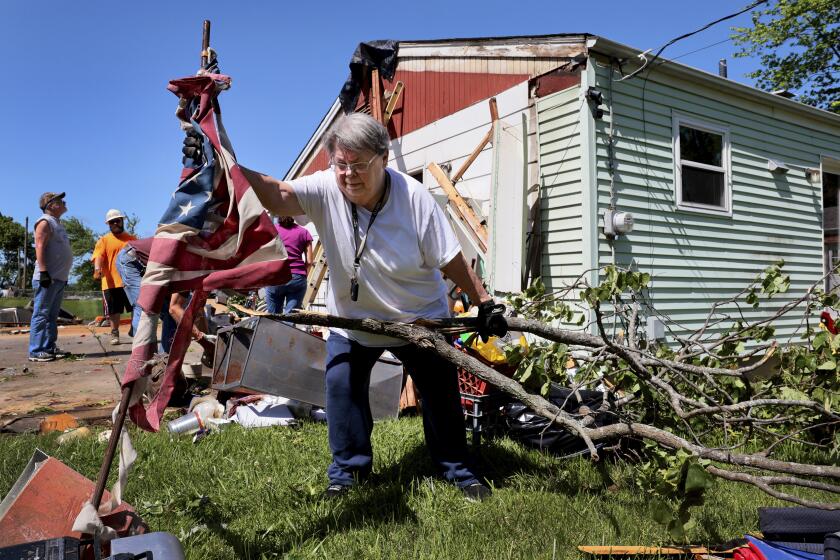Proposed Colorado Ski Resort Becomes an Environmental Battleground
The way Betty Feazel and Dan McCarthy joke with each other, you wouldn’t guess they are on opposite sides of a struggle over a pristine mountain valley in the southern Colorado Rockies.
Feazel and McCarthy have known each other for years. Their families have gone to the Santa Fe Opera together. McCarthy, who lives in Illinois, stays at Feazel’s ranch when he is in Colorado. When they are together, it is easy to see they enjoy each other’s company.
“Nice guy,” Feazel said when asked about McCarthy. “I’m very fond of him personally. I just disagree with his plans.”
Battle Lines Drawn
Those plans form the battle lines between the developer and the ecologist: The developer wants this valley for a ski resort and the ecologist wants it the way it is.
McCarthy bought the valley along the East Fork of the San Juan River in 1970 after looking around the West for a place to build a year-round resort. After years of delays, caused mostly by government studies of potential wilderness areas, McCarthy got approval from the U.S. Forest Service last summer to build a 4,600-acre resort.
The “East Fork” resort needed Forest Service approval because its main attraction would be a large ski area on Quartz Ridge, which is on Forest Service land. The resort would also have a golf course along the valley floor.
Local Industry Collapses
On McCarthy’s side are his partner, Balcor Corp., which is a subsidiary of American Express, and many area residents who see the resort as an economic savior. The main industry in Pagosa Springs, a community of 1,300, is timber, and for all practical purposes it has collapsed.
On the other side of the struggle are numerous environmental groups, including the National Wildlife Federation and local chapters of the Sierra Club and National Audubon Society. They are joined by Betty Feazel, whose ranch lies in the path of an access road to the resort.
Feazel, 71, is no stranger to controversy.
“I always seem to get churned up by my principles,” said Feazel, who was embroiled in civil rights controversies as early as the 1940s and protested Vietnam in the ‘60s and ‘70s.
As she stood on a hill overlooking the valley below McCarthy’s development site, the chain-smoking Feazel said she sympathizes with her friend but believes the environment needs protection. However, McCarthy believes just as strongly that his resort could enhance the environment.
“It’s his own property, but I think there should be limits to the damage to the public interest that people who own property should be allowed to inflict,” Feazel said.
No Personal Gain
“There isn’t any money in this (opposition) for me. I’m not moved by personal gain. It’s a matter of principle. The natural resources are being eaten alive by too much commodity removal, oil and gas exploration, mining, timbering, coal strip mines. These are national resources that belong to all the people of the United States. I’m against Forest Service policy wherever it is commodity-oriented.”
The environmental groups oppose the resort because the area is home to the endangered peregrine falcon and perhaps to lynx and wolverine, as well as being wintering ground for elk and deer herds. Also, they argue, the ski area would be adjacent to the South San Juan Wilderness Area, potentially damaging that resource.
The Ute Mountain Indians, whose reservation is about 40 miles away, also are fighting the project because they say it would damage archeological sites.
McCarthy insists that his resort is compatible with the environment. He began his own environmental studies back in the 1970s, before they were required, and has done some enhancement work on the river bed in consultation with the Forest Service.
“I think East Fork has the capability to overcome all valid objections,” he said. “It already has undergone intense scrutiny. I have a very sensitive feeling about and respect for environmental values, both wildlife and people values, and have had all the time. I know that if I’m in control these will be respected.”
‘Some Degradation’
McCarthy admitted that his resort would result in “some degradation” of the environment. “But I think there will be a lot of enhancements, too,” he said. “It would not be successful if it didn’t improve lots of people’s personal environments.”
Tom Lustig, attorney for the National Wildlife Federation, believes East Fork is symbolic of many pending ski resort proposals nationwide. He hopes that, by stopping one, all the others might be stopped as well.
Lustig and other environmentalists are not so much concerned with the effects of the ski area itself, but rather with the impact of the development at the base of the mountain. The valley floor, and not the mountaintop, is the best habitat for most wildlife.
Lustig points to the development along the Gore Creek-Eagle River valleys in Colorado surrounding the Vail-Beaver Creek resorts. Thirty years ago, those valleys were inhabited only by ranchers, but today they are nearly covered mountain-to-mountain by condominiums and shops. Underpasses had to be built along Interstate 70 to allow deer and elk to migrate through the valleys.
Forest Service policy has been that the agency cannot control development off the national forests and so must ignore what happens at the base of a ski resort when it is doing its environmental studies. Lustig believes the Forest Service does have the authority to control development, because its approval of a ski area has a widespread impact.
‘Off-Site’ Impacts
Eventually, Lustig said, a court will decide if the Forest Service should take into account these “off-site” impacts.
In addition, the wildlife federation intends to attack all new ski developments by arguing that there is no demand for more areas because growth in the ski industry has slowed in recent years. Lustig said the Forest Service refuses to study the economic feasibility of new ski areas.
Jerry Groswold, president of the Winter Park ski area in central Colorado, argues that “ski developers and environmentalists have more in common than they have differences,” because the ski industry wants to protect the outdoor experience that its clients enjoy.
In Colorado, Groswold said, ski areas occupy only .0013% of all Forest Service land, while providing 48,000 jobs and more than $1.5 billion in income. Two-thirds of the income in Grand County, where Winter Park is situated, comes from skiing, he said.
John Lay, president of Colorado Ski Country USA, a ski industry marketing association, said the ski industry should not be unfairly singled out “just because we’re the easiest ones to get your hands around our throats.”
More to Read
Start your day right
Sign up for Essential California for news, features and recommendations from the L.A. Times and beyond in your inbox six days a week.
You may occasionally receive promotional content from the Los Angeles Times.






